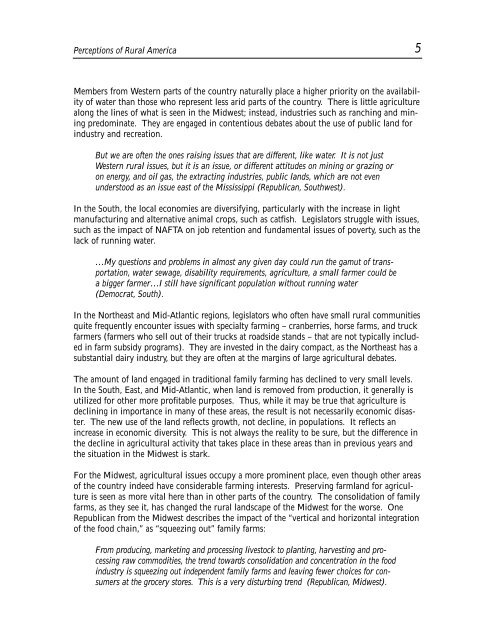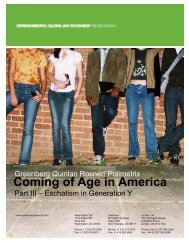803_Congressional Perspectives.pdf - Greenberg Quinlan Rosner
803_Congressional Perspectives.pdf - Greenberg Quinlan Rosner
803_Congressional Perspectives.pdf - Greenberg Quinlan Rosner
- No tags were found...
You also want an ePaper? Increase the reach of your titles
YUMPU automatically turns print PDFs into web optimized ePapers that Google loves.
Perceptions of Rural America5Members from Western parts of the country naturally place a higher priority on the availabilityof water than those who represent less arid parts of the country. There is little agriculturealong the lines of what is seen in the Midwest; instead, industries such as ranching and miningpredominate. They are engaged in contentious debates about the use of public land forindustry and recreation.But we are often the ones raising issues that are different, like water. It is not justWestern rural issues, but it is an issue, or different attitudes on mining or grazing oron energy, and oil gas, the extracting industries, public lands, which are not evenunderstood as an issue east of the Mississippi (Republican, Southwest).In the South, the local economies are diversifying, particularly with the increase in lightmanufacturing and alternative animal crops, such as catfish. Legislators struggle with issues,such as the impact of NAFTA on job retention and fundamental issues of poverty, such as thelack of running water.…My questions and problems in almost any given day could run the gamut of transportation,water sewage, disability requirements, agriculture, a small farmer could bea bigger farmer…I still have significant population without running water(Democrat, South).In the Northeast and Mid-Atlantic regions, legislators who often have small rural communitiesquite frequently encounter issues with specialty farming – cranberries, horse farms, and truckfarmers (farmers who sell out of their trucks at roadside stands – that are not typically includedin farm subsidy programs). They are invested in the dairy compact, as the Northeast has asubstantial dairy industry, but they are often at the margins of large agricultural debates.The amount of land engaged in traditional family farming has declined to very small levels.In the South, East, and Mid-Atlantic, when land is removed from production, it generally isutilized for other more profitable purposes. Thus, while it may be true that agriculture isdeclining in importance in many of these areas, the result is not necessarily economic disaster.The new use of the land reflects growth, not decline, in populations. It reflects anincrease in economic diversity. This is not always the reality to be sure, but the difference inthe decline in agricultural activity that takes place in these areas than in previous years andthe situation in the Midwest is stark.For the Midwest, agricultural issues occupy a more prominent place, even though other areasof the country indeed have considerable farming interests. Preserving farmland for agricultureis seen as more vital here than in other parts of the country. The consolidation of familyfarms, as they see it, has changed the rural landscape of the Midwest for the worse. OneRepublican from the Midwest describes the impact of the “vertical and horizontal integrationof the food chain,” as “squeezing out” family farms:From producing, marketing and processing livestock to planting, harvesting and processingraw commodities, the trend towards consolidation and concentration in the foodindustry is squeezing out independent family farms and leaving fewer choices for consumersat the grocery stores. This is a very disturbing trend (Republican, Midwest).




